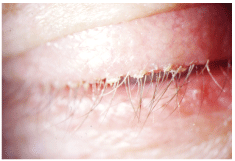 A 48-year-old white male undergoes his annual comprehensive eye examination. His only abnormalities are some mild crusting around the eyelashes and some faint corneal infiltrates. He is diagnosed with a low-grade blepharitis. However, he believes that his symptoms are so mild that the use of medication is unjustified, so he asks about alternate options.
A 48-year-old white male undergoes his annual comprehensive eye examination. His only abnormalities are some mild crusting around the eyelashes and some faint corneal infiltrates. He is diagnosed with a low-grade blepharitis. However, he believes that his symptoms are so mild that the use of medication is unjustified, so he asks about alternate options.
The patient is educated and counseled about the old management standby: lid scrubs and lid hygiene. What practitioner doesnt frequently recommend lid scrubs or lid hygiene regimens to a patient? Its easy, safe, inexpensive, and often satisfies patients.
However, are we merely placating patients by giving them something to do to alleviate a subclinical condition? Are we placating ourselves by only superficially addressing a subclinical condition? Or, are we actually accomplishing something?
This month, we examine the science behind this reliable therapy.
Infectious blepharatis caused by Staphylococcus. Such a condition may be soothed through the use of a lid scrub.

Use When Recommended
These conditions are commonly managed with lid scrubs and hygiene instruction:
Blepharitis is a broad term ascribed to infection or inflammation of the eyelids. It generally involves the eyelashes and eyelid margin, including the sebaceous glands. It is typically bilateral, and patients may complain of itching, burning, foreign body sensation and lacrimation. Crusty or scaly debris in and around the eyelashes, particularly upon waking, is common. Lid erythema, madarosis and meibomian gland plugging may also occur, as well as other complications, such as hordeola, chalazia and marginal sterile keratitis.1
Infectious blepharitis is often associated with poor hygiene and results from bacterial overgrowth, most commonly from Staphylococcus species. Mite infestation by Demodex folliculorum can also cause inflammation. Seborrheic blepharitis results from a dysfunction of the sebaceous glands.
Meibomian gland disease (MGD) is associated with chronic obstruction and inflammation of the meibomian glands, which results in accumulation of meibomian secretions within the glands. Colonized bacteria alter the composition and consistency of these secretions, making them thicker and less soluble, which leads to evaporative dry eye with associated symptoms.2,3
Chalazia are a common inflammatory condition of the eyelid and are typically caused by blockage of the meibomian gland ductules and chronic lipogranulomatous inflammation. A chalazion can affect a patient of any age, race or gender. Common complaints include poor cosmesis, local irritation and, in cases of large lesions, mechanical ptosis and corneal astigmatism.4-6
What is Lid Hygiene?
In most instances, lid hygiene includes the use of warm compresses, heated saline, non-preserved tears and lid scrubs. Scrubs are available commercially, or patients can simply use warm saline on a cotton-tipped applicator or prepare a diluted detergent-based solution with over-the-counter soap, baby shampoo or similar hypoallergenic products on cotton balls or clear wash cloths. Recently, tea tree oil (TTO) has also been used in lid scrub regimens. There is no universally accepted regimen for lid hygiene and lid scrubs, but most practitioners follow a similar course.
Clinical Utility
As we said above, lid hygiene and lid scrubs have long been used to manage most forms of blepharitis.7-11 But, in most studies, patients receive multiple therapies in concert with lid scrubs and lid hygiene, making it difficult to discern the specific benefit of this conservative therapy.
One study that examined the effects of a commercially available lid scrub used alone in patients with chronic blepharitis found a distinct benefit. Most of the 20 patients involved reported significant reduction in the subjective symptoms and the severity of clinical signs.12
In patients with ocular Demodex infestation, lid scrubs with 50% TTO seem to improve clinical outcomes greatly.13-14 Demodex mites cause ocular surface inflammation, MGD and lash abnormalities.
In one study of 11 patients with who received weekly lid scrubs with 50% TTO and daily lid hygiene procedures with tea tree shampoo, the Demodex count dropped to zero over two consecutive visits (in less than four weeks) in eight of the 11 patients. Ten patients showed different degrees of symptomatic relief and reduction of inflammation. There was also an increase in visual function associated with an improvement in lipid tear film stability following lid scrubs and lid hygiene.13
A study of patients with MGD compared lid hygiene to lid hygiene with minocycline treatment. Meibomian fatty acid composition was slightly modified after eight weeks in both groups. Both interventions partly corrected fatty acid composition abnormalities, though minocycline with lid hygiene was more effective than lid hygiene alone.15
Another study examined the effectiveness of lid hygiene therapy in patients with MGD and found subjective and objective benefits. The regimen included applying a heated saline solution, wiping the eyelids with cotton balls and using non-preserved artificial tears, and was administered in 26 patients with MGD for six weeks. Tear film break-up time was prolonged by an average of 3.4 seconds and was normalized to 10 seconds or more in 30% of cases. Symptomatic improvement occurred in 88% of cases.16
Twenty-one patients with contact lens intolerance and MGD were evaluated to determine the efficacy of lid scrubs and lid massage. At two weeks, gland expression, biomicroscopy, staining, comfort and fluorescein break-up time were assessed. Researchers found a significant increase in tear film break-up time in the eyes undergoing the lid hygiene regimen vs. no changes in the unmanaged control eyes. There was also subjective improvement in contact lens comfort following lid hygiene therapy.17
With regard to the efficacy of lid scrubs and lid hygiene in patients with chalazia, there seems to be some benefit. In a small study of 37 patients, lid hygiene resulted in cure of clinical chalazia in 80% of cases.18 But, a smaller case series involved six patients with seven chalazia, who received hot compresses and lid hygiene. These patients saw only a 43% cure rate.19
It appears that there is some benefit to recommending lid hygiene and lid scrubs to patients with MGD, chalazia, and other mild ocular surface disorders. Controlled studies that look solely at the benefit of lid scrubs are rare, and most research combines lid hygiene with other therapies in comprehensive management of the conditions we discussed. It is comforting to know, however, that there is research that identifies the objective and subjective benefits imparted by lid hygiene procedures.
So, the next time that you mention lid scrubs to a patient as if youre tossing off a bon mot, realize that you are indeed suggesting a therapy that has benefit beyond placating the patient (and yourself).
1. Auw-Haedrich C, Reinhard T. Chronic blepharitis. Pathogenesis, clinical features, and therapy. Ophthalmologe 2007 Sep;104(9):817-26.
2. Smith RE, Flowers CW Jr. Chronic blepharitis: a review. CLAO J 1995;21(3):200-7.
3. Driver PJ, Lemp MA. Meibomian gland dysfunction. Surv Ophthalmol 1996;40(5):343-67.
4. Dhaliwal U, Arora VK, Singh N, et al. Cytopathology of chalazia. Diagn Cytopathol 2004 Aug;31(2):118-22.
5. Dhaliwal U, Bhatia A. A rationale for therapeutic decision-making in chalazia. Orbit 2005 Dec;24(4):227-30.
6. Ben Simon GJ, Huang L, Nakra T, et al. Intralesional triamcinolone acetonide injection for primary and recurrent chalazia: is it really effective? Ophthalmology 2005 May;112(5):913-7.
7.
8. Jones SM, Weinstein JM, Cumberland P, et al. Visual outcome and corneal changes in children with chronic blepharokeratoconjunctivitis. Ophthalmology 2007 Dec;114(12):2271-80.
9. Alvarenga LS, Mannis MJ. Ocular rosacea. Ocul Surf 2005 Jan;3(1):41-58.
10. Viswalingam M, Rauz S, Morlet N, et al. Blepharokeratoconjunctivitis in children: diagnosis and treatment. Br J Ophthalmol 2005 Apr;89(4):400-3.
11. Farpour B, McClellan KA. Diagnosis and management of chronic blepharokeratoconjunctivitis in children. J Pediatr Ophthalmol Strabismus 2001 Jul-Aug;38(4):207-12.
12. Avisar R, Savir H, Deutsch D, et al. Effect of I-Scrub on signs and symptoms of chronic blepharitis. DICP 1991 Apr;25(4):359-60.
13. Gao YY, Di Pascuale MA, Elizondo A, et al. Clinical treatment of ocular demodecosis by lid scrub with tea tree oil. Cornea 2007 Feb;26(2):136-43.
14. Kheirkhah A, Casas V, Li W, et al. Corneal manifestations of ocular Demodex infestation. Am J Ophthalmol 2007 May;143(5):743-9.
15. Souchier M, Joffre C, Grgoire S, et al. Changes in meibomian fatty acids and clinical signs in patients with meibomian Br J Ophthalmol 2008 Jun;92(6):819-22.
16. Romero JM, Biser SA, Perry HD, et al. Conservative treatment of meibomian gland dysfunction. Eye Contact Lens 2004 Jan;30(1):14-9.
17. Paugh JR, Knapp LL, Martinson JR, et al. Meibomian therapy in problematic contact lens wear. Optom Vis Sci 1990 Nov;67(11):803-6.
18. Perry HD, Serniuk RA. Conservative treatment of chalazia. Ophthalmology 1980 Mar;87(3):218-21.
19. Garrett GW, Gillespie ME,

